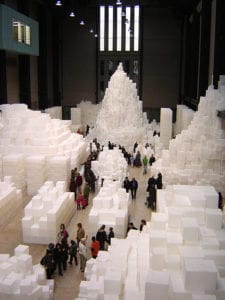The word “interactive” is hard to define because everyone may have their own understanding about it, thus making it a quite subjective concept. But I agree with Crawford’s idea that there’s and should be some common knowledge to establish mutual cognition and he define “interactive” as “a cyclic process with two actors alternatively listen, think and speak.”(5), in other words, “input, process and output”(5).
During my study, I focused in two cases: the SIRI (Speech Interpretation and Recognition Interface) and the Installation Art. Starting from the latter one, the Installation Art is an example of the misunderstanding on what is not interactive. I used to believe that there exist some kind of interaction between the audience and the artists, and the Installation Art is one of the most tricky ones among the genres of art as it is very similar to being “interactive”. Indeed, compared with other traditional forms of arts, the Installation Arts is more open to the audience and allows more participation. However, despite that people may claim that they establish some connection with the author during their appreciation of arts, the connection is neither cyclic nor mutual, thus can not be called as “interactive”. People do understand it step by step, making their recognition alike a conversation, but no mentioning that the steps are actually one process still, the process is irreversible and non-repeatable. Besides, there’s no certain logical relationship between the audience’s input and the artwork’s output, as their participation may only affect their angle of view, and therefore omitting the intermediate phase “process”. The case helps me clarify the concept.

Rachel Whiteread,Embankment at Tate Modern, London
Next is the SIRI. The case helps me further my opinion that the process doesn’t need to be intentional. Making a doll as an example, you can manipulate its limbs, and so it will move, responding to your action. You can get exactly what you has expected to get, for SIRI it is the translation and for a doll it is the movement. But in a wider definition, that is also interactive, as long as there is a logic between the input and the output which can then be called as the phase “process”. The program doesn’t think, but it can also be interactive as the three phases of interactive is included in the calculation. It, which is an exact example of “interactive”, take the voice command as input, transform it into digital signal, then translate it into digital command and produce output accordingly.
So we imagine what if there’s a tool that can translate our thoughts in an non-verbal way, and meanwhile being interactive, so it comes to our project “SMART Floor”. Our project, the “SMART Floor”, is designed to read signals from multiple body sensors (mass, thermo, humidity, movement, hormone, etc.) and also from facial recognition , in which the floor pile can produce different reactions (output) according to different occasions (input) after being processed in the microchip (process) implanted in it, like entertaining a naughty baby/pets, stopping a theft or preventing a fire. The innovation is the mode of the dual-capability of it that the floor itself can be both a sensor and a screen, so the floor it self but not a whole system is interactive.
Work Cited:
Crawford. “What Exactly Is Interactivity.” The Art of Interactivity, pp. 1–6.